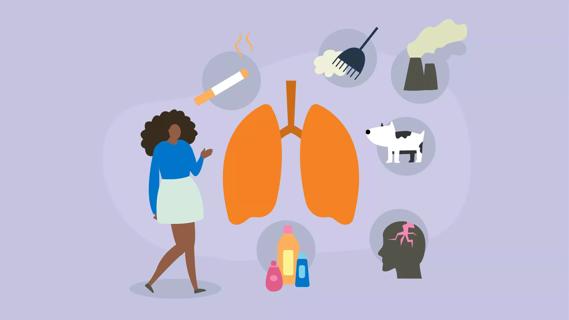And what to do if you have an exercise-induced asthma attack

Going for a run outdoors in shorts and a T-shirt is one of the great joys of summer, right? For people with asthma, however, that relationship status is a bit more complicated.
Advertisement
Cleveland Clinic is a non-profit academic medical center. Advertising on our site helps support our mission. We do not endorse non-Cleveland Clinic products or services. Policy
How can you safely exercise in the summer sun if you have asthma? Pulmonologist Emily Pennington, MD, gives her tips to take advantage of the season.
Exercise helps asthma in two ways, Dr. Pennington says. It increases:
But while exercise helps improve asthma, it can also trigger symptoms. And without a plan in place, exercise can quickly take a turn for the worse.
Enter exercise-induced asthma, which is when physical activity causes the airways in your lungs to narrow. Symptoms generally begin between 5 and 20 minutes after starting an activity.
“There are things we can do to decrease or prevent your symptoms so you can exercise more easily,” says Dr. Pennington. “Speak with your doctor to put a plan in place for how to exercise safely.”
Here are some other ways to play it smart and prevent exercise-induced asthma:
Check weather alerts. “For some patients, extreme temperatures — hot or cold — make it hard to breathe,” Dr. Pennington explains. “And sometimes the quick change in temperature when you leave air conditioning to go out in the heat makes breathing more difficult.”
Advertisement
Hot, humid weather can also increase the amount of pollution in the air, which can exacerbate asthma symptoms. So watch the forecast and air quality index when planning outdoor exercise.
Peruse pollen counts. There is such a thing as allergy-induced asthma, too. So stay inside if you have seasonal allergies and the pollen count is high.
Don’t forget your gear. “Your rescue inhaler is useless sitting at home while you’re out running a five-mile race,” Dr. Pennington says. “Make sure you have it so you can use it if needed.”
She advises using your rescue inhaler 15 minutes before starting an activity. If you feel short of breath while exercising, take a few puffs to get relief within 10 to 15 minutes.
“And if you’ve been prescribed a controller inhaler, make sure you’re using it as directed,” she stresses. “It will help decrease the inflammation in your lungs that causes symptoms.”
Take it slow. Don’t start running or riding your bike at full blast. Warm up first. Take the time to adjust your body to hot temperatures, especially if you are coming from an air-conditioned environment.
Timing is everything. Plan to exercise in the early morning or late evening when it’s cooler outside.
Hydrate, hydrate, hydrate. Asthma or not, always make sure you’re getting enough H2O. “You’re outside. You’re sweating more. It’s hot. Make sure you are not getting dehydrated,” Dr. Pennington stresses.
Know your limits. If you need to take a break, do it. “Warm weather demands more energy because your skin is trying to cool you off and your muscles are working hard,” she explains. “The same activity that you could do inside without a problem might be more challenging outside.”
Safety first. Take your phone with you. Exercise with a friend. Stay close to home. If there is an emergency, you want to be able to get help quickly.
Dr. Pennington recommends exercising as much as feels comfortable. “If your asthma is well-controlled, then the recommendations are the same for everyone: 150 minutes of moderate to high-intensity exercise each week,” she says.
But if you are more symptomatic, start with a smaller goal of exercising once or twice a week. “Once you and your doctor get your asthma under better control, you can work up to exercising more often,” she says.
Dr. Pennington emphasizes the importance of having an action plan in place should you enter the danger zone. Coughing during or after exercise is one sign of an exercise-induced asthma attack.
Other symptoms include wheezing, shortness of breath and a feeling of tightness in the chest. If you experience one or more of these signs, Dr. Pennington recommends following these steps to stay safe:
Advertisement
Advertisement
Learn more about our editorial process.
Advertisement

The effectiveness and safety of many of these options are unknown, so it’s best to stick to traditional care

Avoid triggers like dust, smoke and cold air to lessen your chances of coughing

Developmental changes like puberty and menopause can impact symptom severity

Symptoms may lessen over time, but the condition never truly goes away

Being prepared is key when you have asthma

Some tips to make your next fire safer

A rainy day can spell pain and discomfort for many

Key tip: minimize your exposure

Type 2 diabetes isn’t inevitable with these dietary changes

Applying a hot or cold compress can help with pain